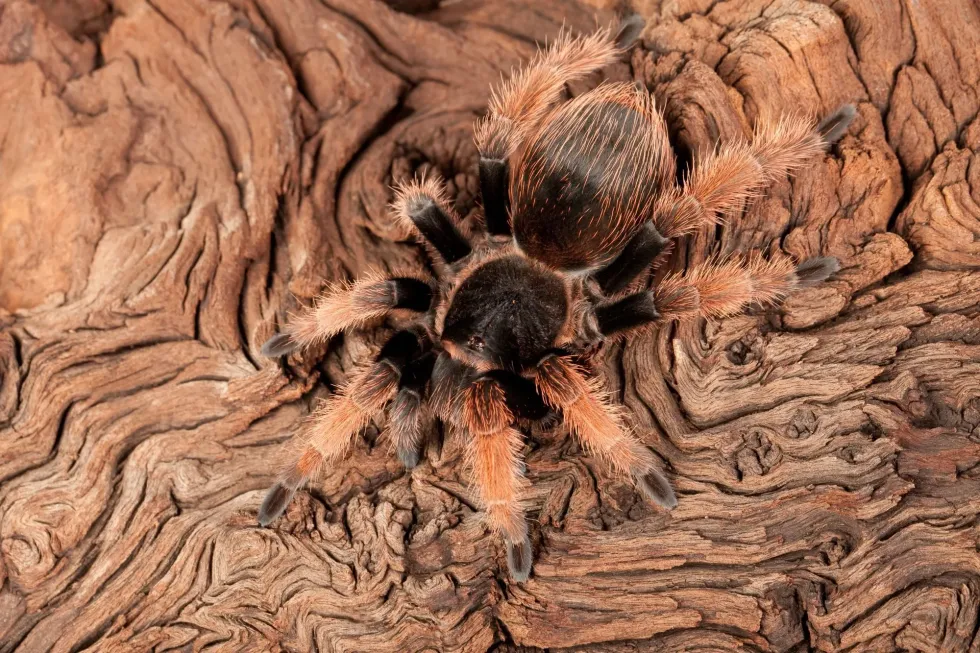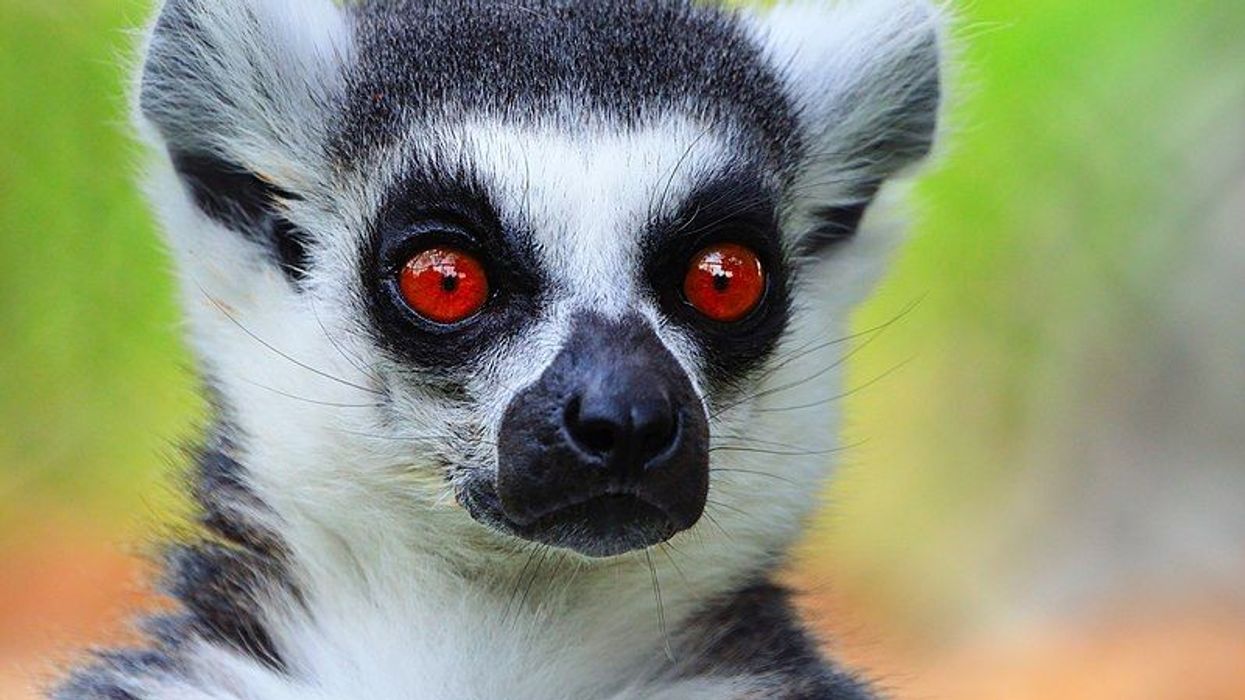Mexican pink tarantula (Brachypelma klaasi), also known as the Mexican pink, Acapulco lesser orange, and Mexican pink beauty, is a medium sized, hairy, diurnal, and one of the rarest and most endangered spiders of the Theraphosidae family.
It is found on the western slopes of the Sierra Madre Occidental, western limits of the Transverse Volcanic Belt in Jalisco and Nayarit, Tepic, Chamela, Southern Pacific coast of Mexico North, and Central America.
Its natural habitat is predominated by burrows, but they also live in tropical rain forests, under fallen logs, inside old tree stumps, large rocks, and large tree roots.
It is a carnivore and adults enjoy a varied food diet of crickets, mealworms, fruit flies, roaches, and other live insects.
The breeding season for the adults is between April and May and females have quite a temperament to their potential suitor and the mating takes place after a female is molted and a meal of the male signifies a successful mating.
The male drums with its pedipalps to get the attention of the female, after which she allows him to raise her and inseminate her.
The male leaves the webbed silk close to the female's burrow after mating and walks away before the female chooses to attack him.
It has docile in behavior and it can also be easily handled as it tends to forgive even in a captive environment, which makes it an ideal pet for humans.
For more relatable content, check out these Carolina wolf spider facts and atlas beetle facts for kids.
Mexican Pink Tarantula Interesting Facts
What type of animal is a Mexican pink tarantula?
It is a colorful, hairy spider endemic to Mexico, belonging to the Theraphosidae family of the kingdom of Animalia.
What class of animal does a Mexican pink tarantula belong to?
Mexican pink, also known as the Mexican pink beauty belongs to the Arachnida class of animals.
How many Mexican pink tarantulas are there in the world?
There are 1000 species of tarantula identified all over the world, but the exact number of these spider species has not been recorded yet. However, their current population trend is decreasing, making them one of the most endangered spiders.
Where does a Mexican pink tarantula live?
Mexican pink beauty (Brachypelma klaasi) is found on the western slopes of the Sierra Madre Occidental, western limits of the Transverse Volcanic Belt in Jalisco and Nayarit, Tepic, Chamela, Southern Pacific coast of Mexico North, and Central America.
What is a Mexican pink tarantula's habitat?
Its natural habitat is predominated by burrows, but they also live in tropical rain forests, under fallen logs, inside old tree stumps, large rocks, and large tree roots, where the temperature is around 77 F (25 C).
Who does Mexican pink tarantula live with?
Mexican pink beauty (B klaasi) is not very social and any attempt to cohabitate with it is likely to end up in cannibalism.
How long does a Mexican pink tarantula live?
Females have a lifespan of up to 30 years in the wild, while the males live significantly shorter, with a lifespan of four to five years.
How do they reproduce?
The breeding season for the adults is between April and May and females have quite a temperament to their potential suitor and the mating takes place after a female is molted and a meal of the male signifies a successful mating.
The male drums with its pedipalps to get the attention of the female, after which she allows him to raise her and inseminate her.
Males leave the webbed silk close to the female's burrow after mating and walk away before the female chooses to attack him.
The average clutch size of the female is up to 800 eggs, which she nests before the rainy season in April or May itself and the babies break free from the sac after eight to 12 weeks.
What is their conservation status?
According to The International Union for Conservation of Nature (IUCN) Red List of Threatened Species, the conservation status of the Mexican pink (Brachypelma klaasi) is Near Threatened and their population trend is decreasing.
Their main threats are housing and urban areas, roads and railroads, annual and perennial non timber crops, hunting and trapping terrestrial animals, armadillos, skunks, snakes, other tarantulas, and tarantula wasps.
Mexican Pink Tarantula Fun Facts
What does a Mexican pink tarantula look like?
The spiderlings are slow to turn into adults and it may take a few years, but the male and female spiders are identical until they reach maturity. Mature males are lankier with tibial hooks and mature females get more stocky.
Their bristles have a uniformly rusty appearance, and they also have black tarsi, orange yellow metatarsi, black femora and coxae, tibias, patellas, large leg span, orange yellow hairs on the opistosoma, and black carapace.
How cute are they?
These tarantulas look quite cute and attractive with their bright pink bristly hair and black body.
How do they communicate?
There is no information provided for the communication of these species but it is known that they are not very socially interactive and the mature males and females communicate only to come together for breeding.
How big is a Mexican pink tarantula?
It is 5.5-6.3 in (14-16 cm) long with a leg span of up to 6 in (15.24 cm).
How fast can a Mexican pink tarantula move?
Exact data about the flying speed of these species has not been recorded yet. It is however known that tarantulas are quite quick in their movements.
How much does a Mexican pink tarantula weigh?
It weighs around 0.04-0.11 lb (19.7-50 g). Females are usually heavier and bigger than males.
What are the male and female names of the species?
There are no sex specific names given to these spiders. They are simply referred to as the male Mexican pink beauty and the female Mexican pink beauty.
What would you call a baby Mexican pink tarantula?
The babies of a Mexican pink tarantula (Brachypelma klaasi) are called spiderlings.
What do they eat?
They are carnivores and the adults enjoy a varied food diet of crickets, mealworms, fruit flies, roaches, and other live insects. The spiderlings, however, eat smaller foods like pinhead crickets, flightless fruit flies, and freshly hatched pinhead rusty red roaches.
Are they poisonous?
There are no records of them biting humans to date, so there is no information about the poison and sensation after the envenomation.
Would they make a good pet?
These tarantulas are quite chilled and docile and they can also be easily handled as they can be quite forgiving even in a captive environment, which makes them an ideal pet for humans.
Did you know...
Mexican pink is one of the most endangered of all the Brachypelma species.
Mexican pink is the only tarantula that creates burrows with two chambers inside.
Mexican pink is the only pink Brachypelma.
Is Brachypelma a Klaasi docile?
It has a fairly docile and calm behavior, yet it gets skittish at times and can be easily spooked. If agitated, its primary defense is to flick its urticating hairs, which are generally harmless.
What is the biggest Brachypelma species?
Mexican red knee tarantula (Brachypelma hamorii) is the biggest Brachypelma species and it is found in the Pacific coast of Mexico, in the states Colima, Jalisco, and Michoacan, and the opposite side of the Balsas River.
Here at Kidadl, we have carefully created lots of interesting family friendly animal facts for everyone to discover! For more relatable content, check out these six eyed sand spider facts and green lynx spider facts pages.
You can even occupy yourself at home by coloring in one of our free printable Mexican pink tarantula coloring pages.









